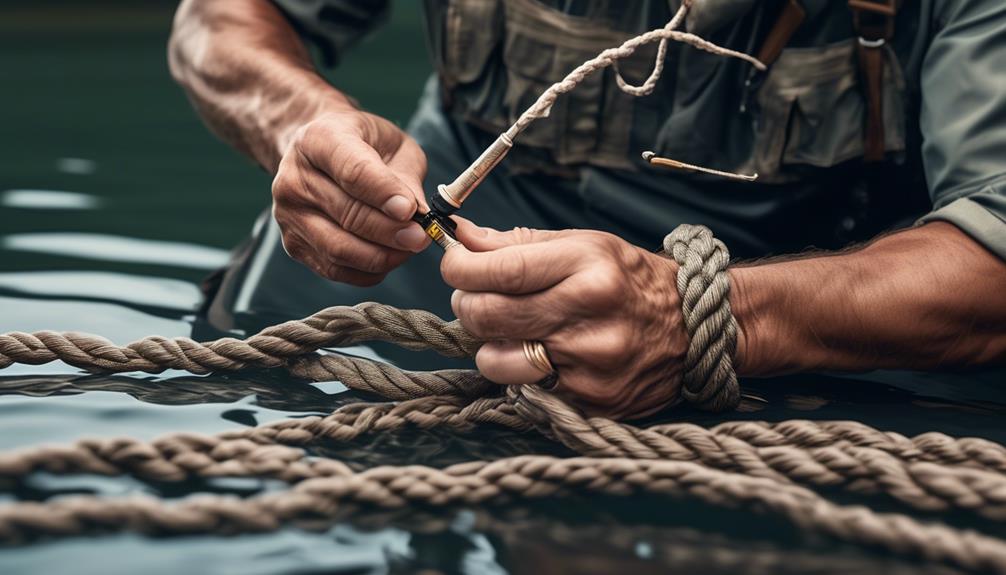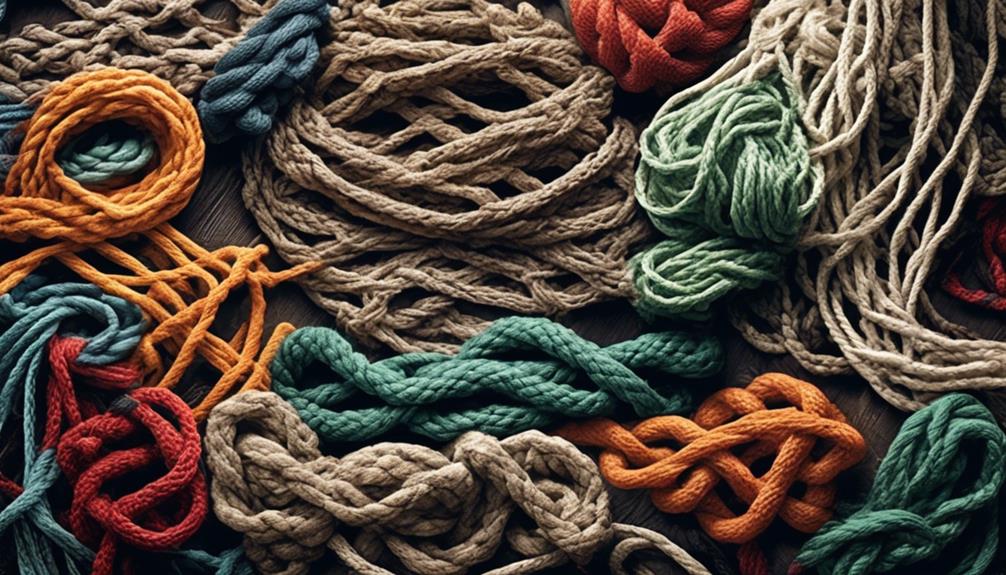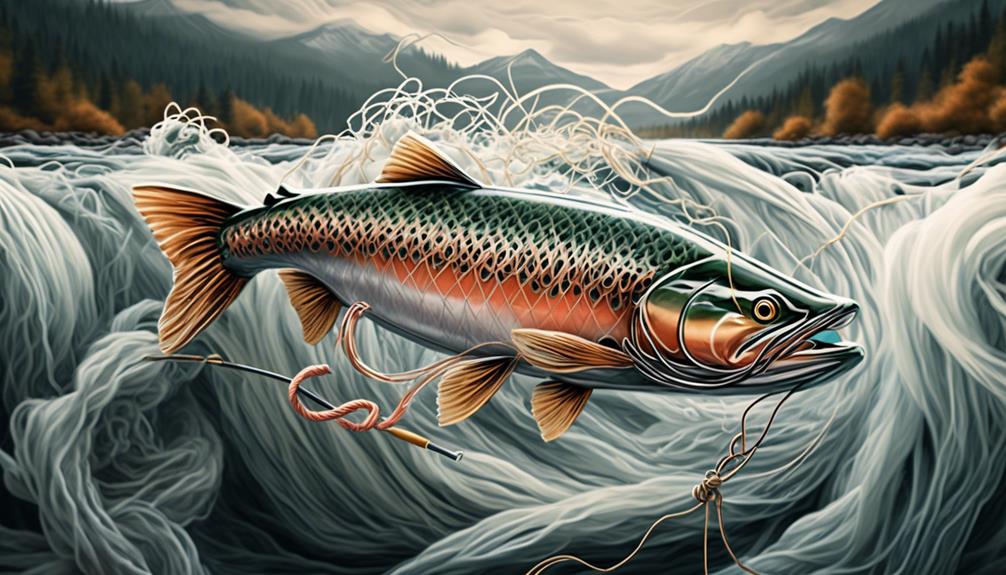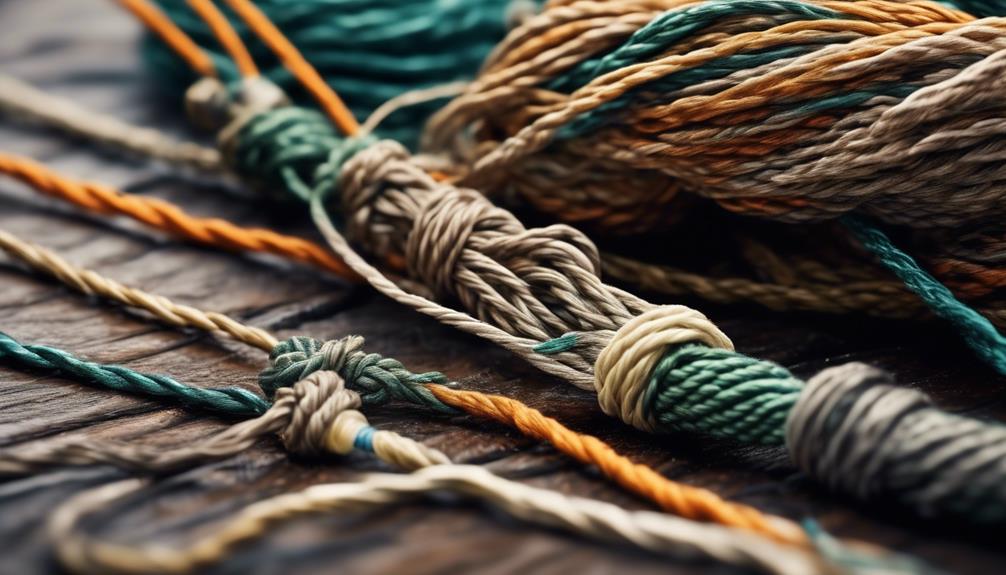So, you've mastered the art of casting your line and reeling in the big ones, but have you truly honed your knot-tying skills? Whether you're a seasoned angler or just starting out, having a repertoire of reliable fishing knots for braided line is crucial to your success on the water.
You might think you have your go-to knots, but what if we told you there are lesser-known knots that could change the game for you? Stick around to uncover the top 10 fishing knots that could take your braided line game to the next level.
Improved Clinch Knot
To secure your braided line effectively, you can rely on the improved clinch knot, which provides a strong and reliable connection between your line and the hook or lure. The improved clinch knot is a popular choice among anglers due to its simplicity and effectiveness. Its benefits include ease of tying, making it suitable for beginners, and its ability to maintain a high percentage of the line's original breaking strength. However, drawbacks of the improved clinch knot include its potential to slip with certain types of lines, such as braided lines, and its tendency to weaken if it's re-tied multiple times. Despite these drawbacks, the improved clinch knot remains a favored option for securing hooks, lures, and swivels to braided lines.
Apart from its traditional use in securing hooks and lures, the improved clinch knot has alternative applications. It can be utilized in various scenarios such as attaching a fly to the leader in fly fishing, connecting the line to a swivel, or even joining two lines together. This versatility makes the improved clinch knot a valuable skill for anglers to master, as it can be employed in a wide range of fishing techniques and situations.
Palomar Knot
Consider mastering the Palomar knot for a reliable and robust connection between your braided line and terminal tackle. The Palomar knot is known for its exceptional strength and is a popular choice among anglers for securing hooks, swivels, and lures to braided lines.
Here are a few reasons why the Palomar knot deserves your attention:
- Palomar Knot Strength: The Palomar knot is renowned for its strength, making it a top choice for securing terminal tackle to braided fishing line. Its double line design distributes the load evenly, minimizing the risk of slippage or breakage, especially when dealing with the high tensile strength of braided lines.
- Simple Tying Process: Despite its remarkable strength, the Palomar knot is surprisingly easy to tie. With just a few simple steps, you can master this knot and have confidence in its ability to hold strong during intense fights with powerful fish.
- Palomar Knot Tying Tips: To ensure maximum strength and reliability, make sure to moisten the knot before tightening it to reduce friction and heat that could weaken the line. Additionally, always double-check the knot for any twists or tangles before fully securing it.
Mastering the Palomar knot can significantly enhance your fishing experience, providing peace of mind knowing that your terminal tackle is securely attached to your braided line, ready to tackle even the toughest catches.
Double Uni Knot
If you want a versatile and reliable knot for connecting different lines, the Double Uni knot is an excellent choice. This knot is especially useful for joining braided line to monofilament or fluorocarbon leaders. The Double Uni knot is known for its simplicity and effectiveness, making it a popular choice among anglers.
When tying the Double Uni knot, line strength and knot security are essential considerations for a successful fishing experience.
Line strength is crucial when using the Double Uni knot. This knot maintains a high percentage of the line's original strength when tied correctly. It's important to ensure that both lines are of similar diameter when using the Double Uni knot to preserve the overall strength of the line. This will prevent weaker lines from compromising the integrity of the knot, reducing the risk of breakage during a fishing excursion.
Knot security is another vital aspect of the Double Uni knot. This knot provides excellent security, ensuring that the lines remain connected even when subjected to the intense pressure of battling a strong fish. Properly cinching the knot and moistening it before tightening are key steps in achieving maximum knot security. The Double Uni knot's ability to maintain its integrity under pressure gives anglers the confidence to tackle challenging catches without worrying about knot slippage.
FG Knot
You may have heard of the FG Knot as a reliable and slim knot used for connecting braided line to monofilament or fluorocarbon leaders. This knot has gained popularity among anglers for its exceptional strength and low profile, making it ideal for casting through rod guides and minimizing the risk of snagging.
The FG knot is a game-changer when it comes to securing your connections, and here's why:
- FG Knot Strength: The FG knot is renowned for its remarkable strength, often outperforming other knots when it comes to connecting braided line to leaders. Its unique wrapping technique creates a firm and reliable bond that can withstand the intense pressure of fighting powerful fish, giving you the confidence to tackle even the most challenging catches.
- FG Knot Tying Technique: While mastering the FG knot tying technique may seem daunting at first, with practice, you can efficiently tie this knot with ease. The key lies in the intricate weaving of the braided line around the leader, creating a seamless connection that maintains the line's original breaking strength. Once you've perfected the tying technique, you'll appreciate the durability and dependability of the FG knot.
- Versatile Application: Whether you're pursuing freshwater or saltwater species, the FG knot proves its versatility in various fishing scenarios. From finesse fishing for bass to battling aggressive saltwater predators, this knot ensures that your line-to-leader connection remains resilient, giving you the upper hand in landing your prized catch.
Mastering the FG knot will undoubtedly elevate your fishing game, providing you with a trustworthy and robust connection that can withstand the rigors of angling.
Albright Knot
The Albright Knot is a versatile and reliable knot used for joining different types of fishing lines together, making it a valuable skill for anglers of all levels. When tied correctly, the Albright knot exhibits excellent strength, making it a popular choice for connecting braided line to monofilament or fluorocarbon leaders. Its strength lies in its ability to distribute pressure evenly across the knot, preventing weak points that could lead to breakage.
The tying technique for the Albright knot involves wrapping the braided line around the leader line and then looping it back through itself multiple times before cinching it down securely. This method creates a strong and streamlined connection, ideal for withstanding the intense fighting power of large fish.
One of the key benefits of using the Albright knot for braided line connections is its ability to smoothly pass through rod guides without causing abrasion or line damage. This is particularly advantageous when dealing with powerful fish species that make strong runs, as the knot's streamlined profile reduces the likelihood of snagging or friction that could result in a lost catch.
Additionally, the Albright knot offers a low profile, ensuring that it can easily travel through the water and present bait or lures naturally, without being impeded by a bulky or cumbersome connection. Mastering the Albright knot provides anglers with a reliable and strong method for seamlessly joining different lines, enhancing their overall fishing experience.
Blood Knot
When joining two lines of similar diameter, the blood knot is a reliable and secure option for anglers seeking a strong connection. This classic knot is particularly useful when connecting monofilament or fluorocarbon lines.
Here are some key points to consider when using the blood knot:
- Advantages of Blood Knot:
- The blood knot maintains a high portion of the lines' original strength when tied correctly.
- It's a low-profile knot, which allows for smooth movement through rod guides and water.
- The knot is relatively easy to tie once mastered, making it a valuable skill for anglers.
- Disadvantages of Blood Knot:
- Tying the blood knot can be challenging, especially for beginners, due to its intricate wrapping technique.
- If the wraps aren't cinched tight and evenly, the knot may slip or fail under heavy pressure.
- The blood knot isn't suitable for connecting lines of different diameters, unlike some other knots.
When it comes to tying the blood knot, the key is to keep the wraps neat and evenly spaced. To achieve this, moistening the knot with saliva or water before pulling it tight can prevent friction and heat buildup, reducing the risk of weakening the lines. Practice and patience are crucial, as mastering the technique will ensure a reliable connection every time. Remember, practice makes perfect when it comes to tying the blood knot.
San Diego Jam Knot
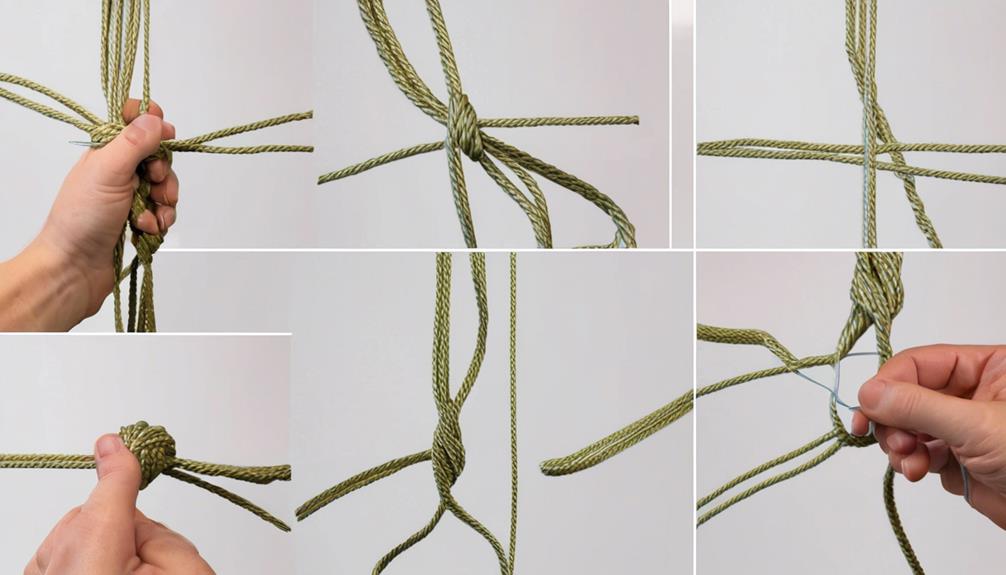
Mastering the blood knot gives you a strong foundation for learning the San Diego Jam Knot, a versatile and reliable option for securing braided lines. The San Diego Jam Knot, also known as the Reverse Clinch Knot, offers several benefits that make it a popular choice among anglers.
One of the main advantages is its strength and reliability, making it ideal for handling the high tensile strength of braided lines. Additionally, this knot maintains a low profile, allowing it to easily pass through rod guides without causing any obstructions during casting or retrieval.
When it comes to tying the San Diego Jam Knot efficiently, there are a few tips to keep in mind. Firstly, ensure that you double the braided line before creating the initial twists to form the knot. This will provide added security and prevent slippage, especially when dealing with slippery braided lines.
Secondly, always moisten the knot before tightening it to reduce friction and prevent any potential damage to the line.
Lastly, make sure to cinch the knot gradually and consistently to ensure a tight and secure hold. Taking these steps will help you tie the San Diego Jam Knot with ease and confidence, allowing you to spend more time focused on your fishing experience.
With its strength, reliability, and ease of tying, the San Diego Jam Knot is a valuable asset for any angler using braided lines.
Double Palomar Knot
To tie the Double Palomar Knot, start by doubling the braided line to create a loop. Then, pass the loop through the eye of the hook or lure and tie a simple overhand knot, creating a loop with the hook or lure hanging from the bottom.
After that, take the loop and pass it over the hook or lure, then tie another overhand knot with the loop, but don't tighten it completely. Finally, wet the line and pull the tag end and standing line simultaneously to cinch the knot tight against the eye of the hook or lure.
When it comes to knot strength, the Double Palomar Knot is known for its exceptional durability. It retains almost the full line strength, making it a reliable choice for securing your hook or lure to braided line. This knot is especially beneficial for handling larger fish species, providing the necessary strength and security to reel in your catch without the fear of knot failure.
In terms of knot tying techniques, the Double Palomar Knot is relatively easy to learn and tie, even for beginners. With its simple yet effective process, anglers of all skill levels can quickly master this knot, adding it to their repertoire of essential fishing skills.
Whether you're a seasoned angler or just starting, mastering the Double Palomar Knot can significantly enhance your fishing experience.
Frequently Asked Questions
What Are the Best Types of Braided Line to Use With Each of These Fishing Knots?
When using different types of braided line, it's important to match the right fishing knot for each one. Understanding the knot compatibility with the specific braided line is crucial for success.
Some of the best fishing knots for braided lines include the Palomar knot, improved clinch knot, and the double uni knot. Each knot has its strengths and is ideal for specific types of braided line, ensuring a secure and reliable connection.
Are There Any Specific Techniques or Tips for Tying These Knots in Different Weather Conditions?
When tying knots in different weather conditions, consider using alternative techniques to ensure knot strength.
In windy conditions, try using heavier lines or adding an extra loop to your knots for added security.
In wet weather, make sure to thoroughly dry your line before tying to prevent slippage. Additionally, applying a small amount of saliva or lubricant to the knot can help with tightening and reduce friction.
Can These Knots Be Used for Different Types of Fishing, Such as Saltwater or Freshwater Fishing?
Yes, these knots can be used for different types of fishing, like saltwater or freshwater fishing. They're versatile and work well with different line strengths and abrasion resistance.
Using knot tying tools and lubricants can make tying these knots easier and more secure.
Whether you're fishing in saltwater or freshwater, these knots are reliable and strong for securing braided line to hooks, swivels, and lures.
Are There Any Alternatives to These Knots That May Be Better Suited for Certain Fishing Situations?
Looking for alternative techniques? Specialized applications might call for different knots. Consider factors like line type, target fish, and environmental conditions.
Some anglers prefer specific knots for certain situations, like the Palomar knot for braid in freshwater or the FG knot for heavy saltwater use.
Experiment with various knots to find what works best for your fishing style and needs.
How Do These Knots Hold up Over Time and in Different Water Conditions?
Over time and in different water conditions, these knots hold up well, offering impressive knot strength and longevity.
They've minimal impact on lure action and casting distance, making them reliable choices for various fishing situations.
Their durability and performance make them suitable for most fishing scenarios, giving you peace of mind and confidence in your tackle.
Conclusion
So there you have it, the 10 best fishing knots for braided line.
Whether you're a beginner or a seasoned angler, these knots will help you secure your line and catch more fish.
Practice tying them until they become second nature, and you'll be prepared for any fishing situation.
Happy fishing!
